Crop details
Scientific Name
Capsicum spp. (C. annuum, C. frutescens)
Order / Family
Solanales: Solanaceae
Local Names
Pilipili (Swahili)
Common Names
Sweet pepper, Bell pepper, Chilli, Hot pepper
General Information
All chilli peppers are varieties of several plant species in the genus Capsicum, including Capsicum annuum (e.g. jalapeños and cayennes), C. frutescens (e.g. tabasco and piri piri), C. chinense (e.g. habaneros and Scotch bonnet), C. pubescens (e.g. rocoto and locoto) and C. baccatum (e.g. aji peppers) and their hybrids which include some of the hottest peppers known. Unsurprisingly, the plants are most commonly grown for the harvest of their fruits, which are used as a spice. Hot peppers are perennial plants with varying structure. They can be herbaceous or shrub-like but are generally branching with green-brown stems and simple oval leaves. The plants produces flowers with five teeth (petals) which are usually white in color. Chilli pepper plants can reach heights in the range of 0.5 to 1.5 m (1.6–4.9 ft) tall and although they are perennial species, they are commonly grown as annuals, with fruit being harvested for one growing season. Chilli peppers may also be referred to as hot peppers or hot chillis. C. annuum species are believed to have originated from Mexico, while the others are all likely to have originated from South America.

Chilli pepper flower

Habaneros

Pepper flower buds

Thai chilli peppers

Habanero fruits ripening on the plant

Cayenne pepper fruit
climatic conditions, soil and water management
Capsicum peppers tend to tolerate shade conditions up to 45% of prevailing solar radiation, although shade may delay flowering. Capsicum peppers grow best on well-drained loamy soils at pH 5.5-6.8. They grow at a wide range of altitudes, with rainfall between 600- and 1250-mm. Severe flooding or drought is injurious to most cultivars. Seeds germinate best at 25-30°C. Optimal temperatures for productivity are between 18 and 30°C. C. frutescens are more tolerant to high temperatures. Cooler night temperatures down to 15°C favor fruit setting, although flowering will be delayed as temperatures drop below 25°C. Flower buds will usually abort rather than develop to maturity if night temperatures reach 30°C. Pollen viability is significantly reduced at temperatures above 30°C and below 15°C.
Chillie paper varieties
Cultivars commonly grown in Kenya:
Sweet pepper (C. annuum):
- California Wonder
- Yolo wonder
- Emerald Giant
- Ruby Giant
Hot pepper (C. frutescens)
- Anaheim
- Fresno
- Jalapeno
- Long Red Cayenne
- Rocket
- Short Bullet
Nutrition Value
Chili peppers have amazingly high levels of vitamins and minerals. Just 100 g provides (in % of recommended daily allowance):
240% of vitamin-C (Ascorbic acid),
39% of vitamin B-6 (Pyridoxine),
32% of vitamin A,
13% of iron,
14% of copper,
7% of potassium,
Uses
Hot peppers can be eaten fresh or cooked as a vegetable, seasoning or garnish.
Propagation
Basic requirements
Peppers are warm-season crops and grow best at temperatures between 18 and 30°C (65–86°F). They can be grown in many soil types although sandy soils warm faster in Spring and are good for early planting. The soil should have a pH between 6 and 7. Peppers will not tolerate water saturated soil and should be planted in a well draining soil or raised bed. Peppers should be planted in an area that receives full sun for most of the day.
Sowing seeds
In most cases, pepper seeds should be started indoors 8–10 weeks before the last Spring frost. Pepper should only be direct seeded in areas with a long, warm growing season, otherwise seeds should be sown indoors in flats or cell trays using a sterile seedling mix. Plant seeds to a depth of 1.3 cm (1/2 in) and water lightly. Seeds should not be allowed to dry out as there will be a negative impact on germination rates.Trays should be positioned in a warm, bright, South facing window or under fluorescent lighting. The optimum soil temperature for germination is 21–29°C(70–85°F). A heat mat can be used to warm the flats if required. Seedlings will emerge within 8–25 days and after the seedlings has developed two sets of true leaves then they can be moved to a larger (3-4 in) pot. Seedlings should be provided with ample light and adequate fertilizer.
Transplanting
Peppers are usually transplanted 2–3 weeks after the last frost when the soil temperature has reached a minimum of 15.5°C (60°F). Covering soil with dark plastic or mulch a week prior to planting outdoors can help bring the soil temperature up more quickly in colder regions, allowing earlier planting. Beginning approximately 7–10 days before transplanting, plants should be set outside to harden off (see https://www.plantvillage.com/posts/264). The hardening off process is very important as peppers are very susceptible to transplant shock. The planting site should be prepared by incorporating plenty of organic matter to encourage vegetative growth. When transplanting seedlings, allow 30–45 cm (12–18 in) between plants and 60–76 cm (24–30 in) between rows. Side dress plants with a nitrogen fertilizer at planting. Drip or soaker irrigation is preferred to overhead irrigation and plants should be watered evenly to keep them moist. Mulching around the plants can also help to conserve soil moisture.
General care and maintenance
Peppers will benefit from applications of fertilizer to keep them supplied with essential nutrients. A timed release fertilizer can be applied at bloom or the plants can be fed with a liquid fertilizer at planting and every two weeks thereafter. In addition, pepper plants can produce a heavy load of fruit and it can be helpful to provide the plants with some support using stakes or cages to prevent branches from breaking under the weight. Use a soft material to tie plants to stakes or cages.

Caged hot peppers

Jalapeno seedlings

Pepper seedlings
References
Burt, J. (2005). Growing capsicums and chillies. Government of Western Australia Department of Agriculture and Food. Available at: http://archive.agric.wa.gov.au/objtwr/imported_assets/content/hort/veg/cp/capsicums/f06499.pdf. [Accessed 11 November 14].
Free to access.
CABI Crop Protection Compendium. (2008). Capsicum datasheet. Available at: http://www.cabi.org/cpc/datasheet/15783. [Accessed 11 November 14].
Paid subscription required.
Pernezny, K. L., Roberts, P. D., Murphy, J. F. & Goldberg, N. P. (Eds.) (2003). Compendium of Pepper Diseases. American Phytopathological Society Press. Available at: http://www.apsnet.org/apsstore/shopapspress/Pages/43003.aspx.
Available for purchase from APS Press.
Valenzueka, H. (2011). Farm and Forestry Production and Marketing Profile for Chili Pepper (
Capsicum annum). In Elevitch, C. R. (ed.). Speciality Crops for Pacific Island Agroforestry. Permanent Agricultural Resources (PAR). Available at: http://www.agroforestry.net/images/pdfs/Chili_Pepper_specialty_crop.pdf. [Accessed 11 November 14].
Free to access.
Common Pests and Diseases
Diseases
Category : Bacterial
Bacterial spot
Xanthomonas vesicatoria

Lesions on capsicum fruit

Symptoms of bacterial spot on red chili foliage

Symptoms of bacterial spot on red chili foliage

Symptoms of bacterial spot on red chili foliage
Symptoms
Water-soaked lesions that dry out and turn brown forming on the underside of the leave; raised brown cankers on stems; cracked brown lesions on fruit.
Cause
Bacterium
Comments
Management
Use disease free planting material; remove and destroy all crop debris after harvest, or plow material deeply under soil.
Category : Fungal
Damping-off
Pythium spp.
Rhizoctonia solani

Shriveled stem of pepper seedling caused by damping-off
Symptoms
Seeds did not germinate; seedlings collapsing and dying; dark stems which are shriveled near the soil line; water-soaked lesions on the stem; water-soaked discolored roots.
Cause
Fungi
Comments
Management
Avoid planting in poorly draining, cool, wet soil; planting in raised beds will help with soil drainage; plant high quality seed that germinates quickly; treat seeds with fungicide prior to planting to eliminate fungal pathogens.
Fusarium wilt
Fusarium oxysporum most likely
Symptoms
Yellowing of foliage and wilting upper leaves; wilting spread to all parts of plant; leaves remain attached to plant and are dark green in color; red-brown discoloration of vascular tissue; plant death.
Cause
Fungus
Comments
Management
Plant pepper in well draining soils and avoid water logging.
Powdery mildew
Leveillula taurica

Powdery mildew symptoms on pepper leaf

Powdery mildew symptoms on pepper leaf
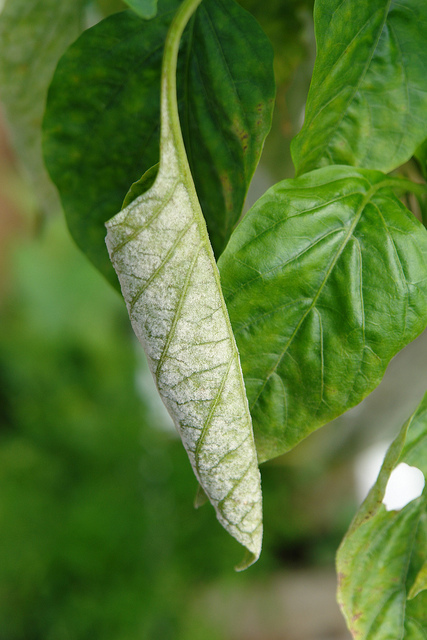
Powdery mildew symptoms on pepper leaf
Symptoms
White, powdery growth on underside of leaves which starts in patches but starts to spread across whole leaves, including the top surface; yellow-brown discoloration on underside of leaves; leaves curling.
Cause
Fungus
Comments
Management
Apply appropriate fungicide if disease is severe.
Southern blight
Sclerotium rolfsii

Yellow patches in the field of sweet pepper where the disease has struck

Pepper plant infected with southern blight disease

Symptoms of southern blight (Sclerotium rolfsii) on pepper plant

Southern blight girdles the lower stem and causes the plant to die

Ropey mycelium of Sclerotium rolfsii on the lower stem

Infected lower stem showing mustard seed-sized sclerotia.
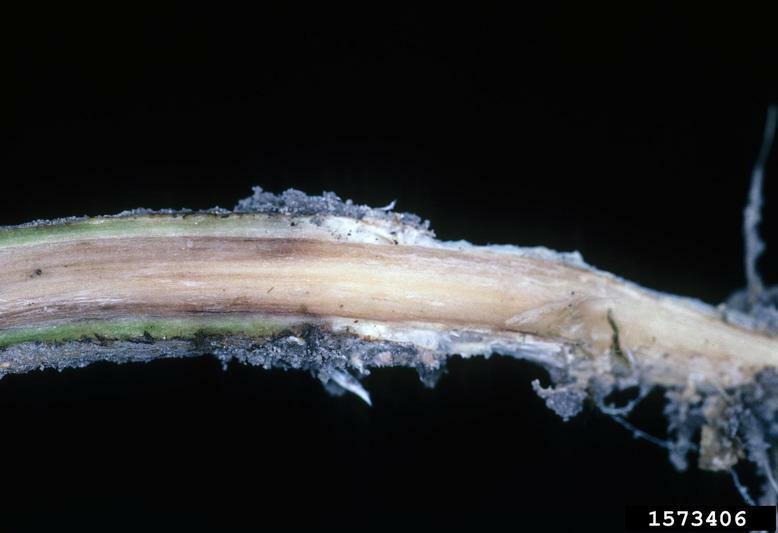
Cross-section through the lower stem of sweet pepper shows the degree of tissue discoloration
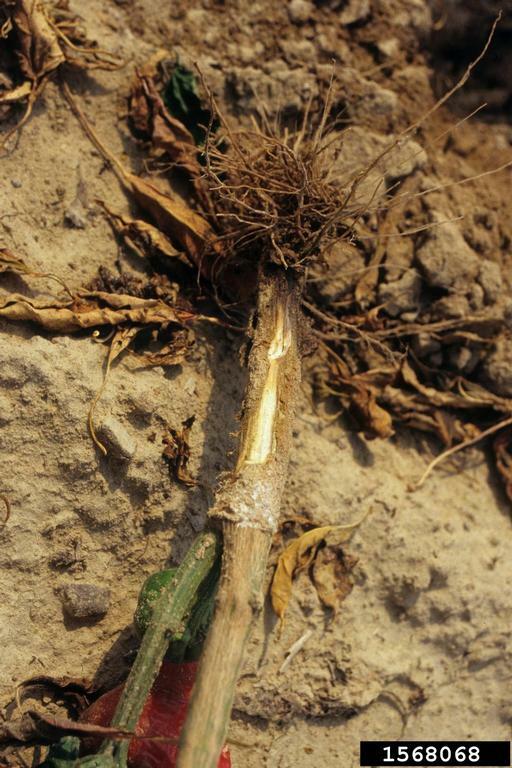
Browning sweet pepper stem above and below soil due southern blight disease

Stem of sweet pepper plant covered with fan-like mycelial mat
Symptoms
Sudden wilting of leaves; yellowing foliage; browning stem above and below soil; browning branches; stem may be covered with fan-like mycelial mat.
Cause
Fungus
Comments
Management
Remove infected plants; avoid overcrowding plants to promote air circulation; rotate crops with less susceptible plants; plow crop debris deep into soil; provide a barrier to infection by wrapping lower stems of plant with aluminum foil covering below ground portion of stem and 2-3 in above soil line.
Category : Viral
Mosaic
Cucumber mosaic virus (CMV)
Potato virus Y (PVY)

Symptoms on pepper leaves
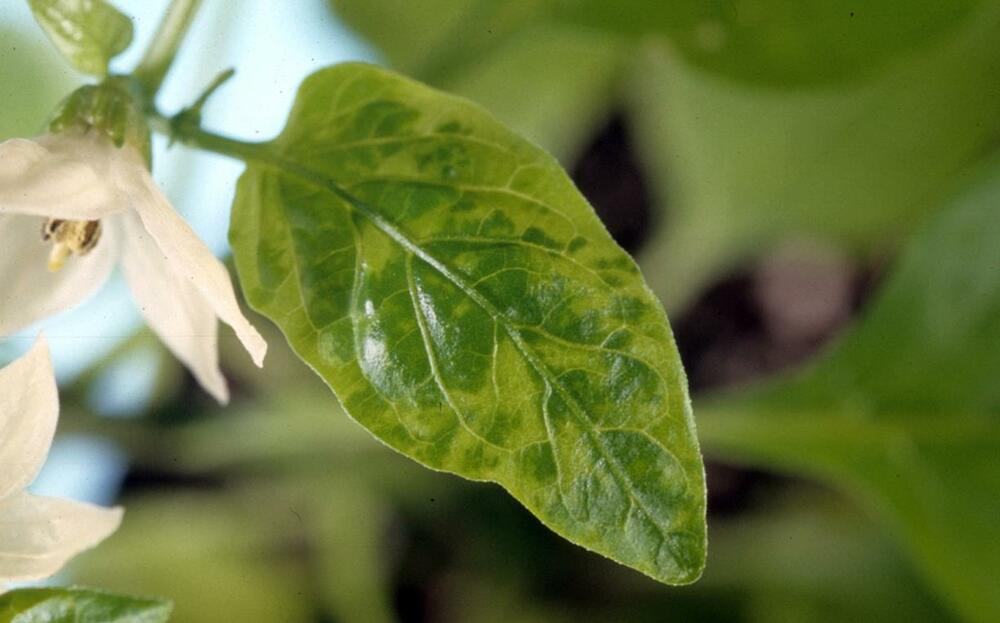
Cucumber mosaic virus symptoms on pepper foliage
Symptoms
Alternating light and green areas or mosaic patterns on the leaves; leaves distorted and curled; slow plant growth.
Cause
Virus
Comments
Management
Remove weeds around crop; use reflective mulches to deter aphids from plants.
Category : Oomycete
Phytophthora blight
Phytophthora caspsici
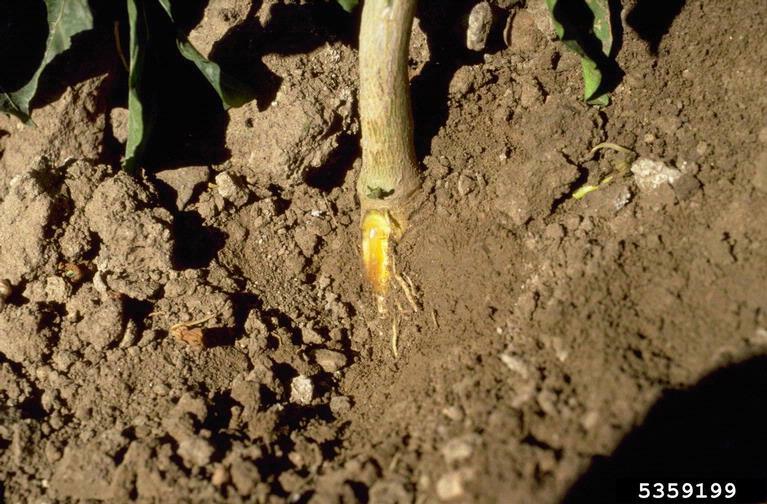
The xylem of a pepper plant infected with Phytophthora wilt caused by Phytophthora capsici.

Pepper infected with Phytophthora blight

A field of pepper plants infected with Phytophthora wilt caused by Phytophthora capsici.

An uprooted pepper plant infected with Phytophthora wilt caused by Phytophthora capsici.
Symptoms
Black lesions on stems; wilting plant; circular gray-brown lesions on leaves; dark lesions on fruit which may be covered in white sporangia.
Cause
Oomycete
Comments
Management
Plant disease free transplants; manage water carefully as pathogen depends on water for survival; rotate crops; apply appropriate fungicide.
Pests
Category : Insects
Aphids
Myzus persicae

Potato aphid (Macrosiphum euphorbiae) on chilli pepper leaves

Aphids (and ladybug larva) on pepper leaf
Symptoms
Small soft bodied insects on underside of leaves and/or stems of plant; usually green or yellow in color, but may be pink, brown, red or black depending on species and host plant; if aphid infestation is heavy it may cause leaves to yellow and/or distorted, necrotic spots on leaves and/or stunted shoots; aphids secrete a sticky, sugary substance called honeydew which encourages the growth of sooty mold on the plants.
Cause
Insect
Comments
Management
If aphid population is limited to just a few leaves or shoots then the infestation can be pruned out to provide control; check transplants for aphids before planting; use tolerant varieties if available; reflective mulches such as silver colored plastic can deter aphids from feeding on plants; sturdy plants can be sprayed with a strong jet of water to knock aphids from leaves; insecticides are generally only required to treat aphids if the infestation is very high - plants generally tolerate low and medium level infestation; insecticidal soaps or oils such as neem or canola oil are usually the best method of control; always check the labels of the products for specific usage guidelines prior to use.
Beet armyworm
Spodoptera exigua

Beet armyworm egg mass hatching
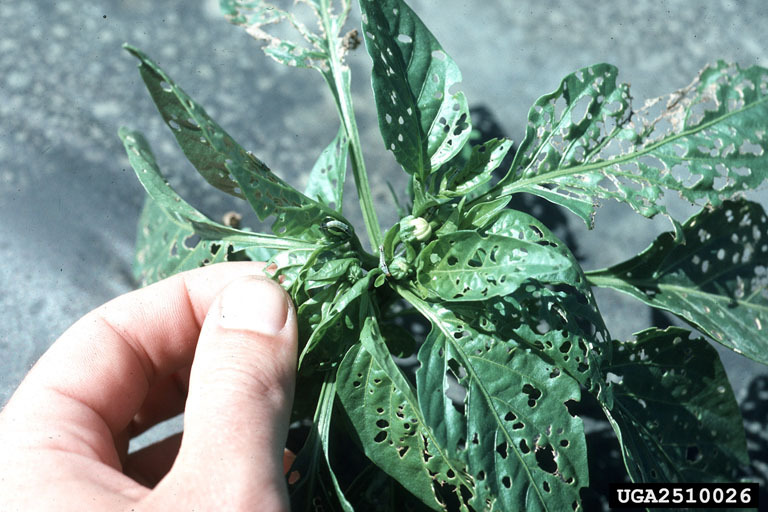
Damage caused by beet armyworm

Late stage beet armyworm larva feeding on pepper leaf
Symptoms
Singular, or closely grouped circular to irregularly shaped holes in foliage; heavy feeding by young larvae leads to skeletonized leaves; shallow, dry wounds on fruit; egg clusters of 50-150 eggs may be present on the leaves; egg clusters are covered in a whitish scale which gives the cluster a cottony or fuzzy appearance; young larvae are pale green to yellow in color while older larvae are generally darker green with a dark and light line running along the side of their body and a pink or yellow underside.
Cause
Insect
Comments
Management
Organic methods of controlling armyworms include biological control by natural enemies which parasitize the larvae and the application of Bacillus thuringiensis; there are chemicals available for commercial control but many that are available for the home garden do not provide adequate control of the larvae.
Flea beetles
Various

Adult flea beetle on a leaf

Flea beetles are often metallic in appearance
Symptoms
Small holes or pits in leaves that give the foliage a characteristic “shothole” appearance; young plants and seedlings are particularly susceptible; plant growth may be reduced; if damage is severe the plant may be killed; the pest responsible for the damage is a small (1.5–3.0 mm) dark colored beetle which jumps when disturbed; the beetles are often shiny and metallic in appearance.
Cause
Insects
Comments
Management
In areas where flea beetles are a problem, floating row covers may have to be used prior to the emergence of the beetles to provide a physical barrier to protect young plants; plant seeds early to allow establishment before the beetles become a problem - mature plants are less susceptible to damage; trap crops may provide a measure of control - cruciferous plants are best; application of a thick layer of mulch may help prevent beetles reaching surface; application on diamotecoeus earth or oils such as neem oil are effective control methods for organic growers; application of insecticides containing carbaryl, spinosad, bifenthrin and permethrin can provide adequate control of beetles for up to a week but will need reapplied.
Leafminers
Lyriomyza spp.

Leafminer trails on pepper leaves
Symptoms
Thin, white, winding trails on leaves; heavy mining can result in white blotches on leaves and leaves dropping from the plant prematurely; early infestation can cause fruit yield to be reduced; adult leafminer is a small black and yellow fly which lays its eggs in the leaf; larave hatch and feed on leaf interior.
Cause
Insects
Comments
Management
Check transplants for signs of leafminer damage prior to planting; remove plants from soil immediately after harvest; only use insecticides when leafminer damage has been identified as unnecessary spraying will also reduce populations of their natural enemies.
Leafroller (Omnivorous leafroller)
Platynota stultana

Larvae of omnivorous leafroller (Platynota stultana)
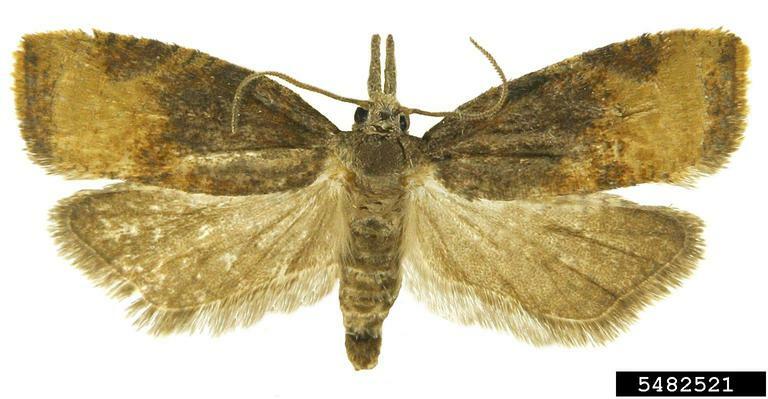
Adult omnivorous leafroller (Platynota stultana)
Symptoms
Leaves of plant rolled and tied together with silk webbing; feeding damage to rolled leaves; defoliation of plant; silk webbing may also be present on fruits and fruits may have substantial scarring from feeding damage; larvae wriggle vigorously when disturbed and may drop from plant on a silken thread.
Cause
Insect
Comments
Management
Monitor plants regularly for signs of infestation; remove weeds from plant bases as they can act as hosts for leafrollers; avoid planting pepper in areas where sugarbeet or alfalfa are grown nearby; Bacillus thuringiensis or Entrust SC may be applied to control insects on organically grown plants; apply sprays carefully to ensure that treatment reaches inside rolled leaves.
Pepper weevil
Anthonomus eugenii

Pepper weevil larvae
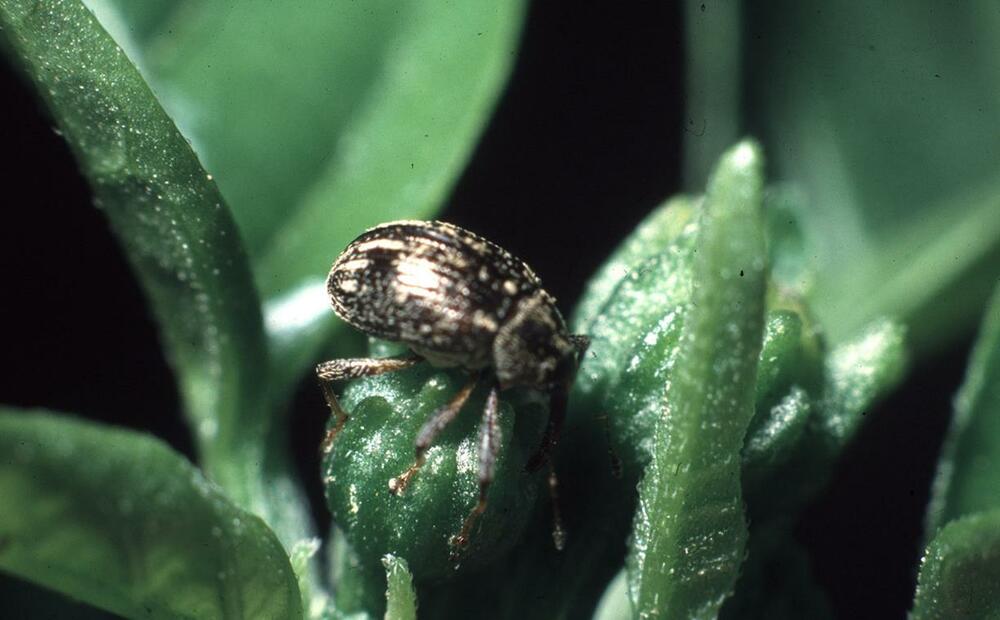
Adult pepper weevil
Symptoms
Feeding damage to foliage, buds and tender young fruit pods; larvae feed within buds and fruit; older fruit misshapen and discolored; buds and fruit may drop from plant; adult weevil is a small black beetle; larvae are small cream-white grubs with brown heads which can reach 0.6 cm (0.25 in) in length when mature.
Cause
Insect
Comments
Management
Remove any nightshade plants growing in close proximity to pepper; immediately remove any dropped fruit from soil surface; if pepper weevil becomes problematic, rotate crop the following year; organically acceptable control methods include sprays of pyrethrin; destroy pepper crop residue immediately after harvest.
Thrips (Western flower thrips, Onion thrips, etc.)
Frankliniella occidentalis
Thrips tabaci

Chilli thrips (Scirtothrips dorsalis) damaged plant

Thrips infestation in a pepper blossom
Symptoms
If population is high leaves and buds may be distorted; leaves appear silvery and are speckled with black feces; insects will feed on and damage flowers; most damage occurs through the transmission of Tomato spotted wilt virus (TSWV); insect is small (1.5 mm) and slender and best viewed using a hand lens; adult thrips are pale yellow to light brown and the nymphs are smaller and lighter in color.
Cause
Insect
Comments
Management
Avoid planting next to onions, garlic or cereals where very large numbers of thrips can build up; use reflective mulches early in growing season to deter thrips; apply appropriate insecticide if thrips become problematic.
Tomato fruit worm (Corn earworm)
Helicoverpa zea

Adult cornworm
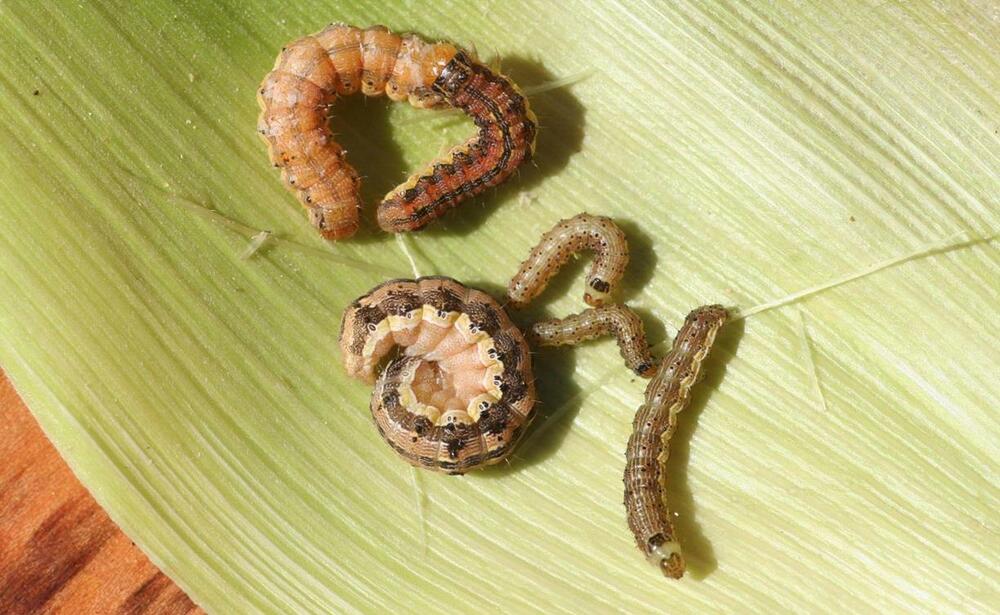
Mixture of larvae showing range of colors
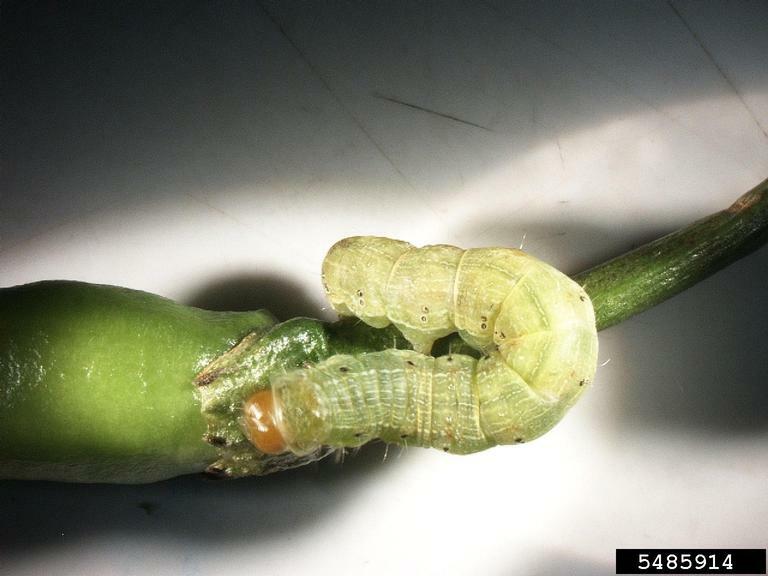
Cornworm on chilli pepper

Early instar larva feeding on pepper bud
Symptoms
Larvae burrowing into fruit near stem end and feeding on fruit interior causing decay; fruit turn red prematurely and fall from plant causing reduced yield; young caterpillars are cream-white in color with a black head and black hairs; older larvae may be yellow-green to almost black in color with fine white lines along their body and black spots at the base of hairs; eggs are laid singly on both upper and lower leaf surfaces and are initially creamy white but develop a brown-red ring after 24 hours and darken prior to hatching.
Cause
Insect
Comments
Management
Early treatment of tomato fruitworms is necessary as once they enter the fruit they are protected from sprays; monitor plants for eggs and young larvae and also natural enemies that could be damaged by chemicals; Bacillus thuringiensis or Entrust SC may be applied to control insects on organically grown plants; appropriate chemical treatment may be required for control in commercial plantations.
Category : Mites
Spider mites (Two spotted spider mite)
Tetranychus urticae

Close-up view of two-spotted spider mites (Tetranychus urticae)

Spider mite damage on under surface of pepper leaves
Symptoms
Leaves stippled with yellow; leaves may appear bronzed; webbing covering leaves; mites may be visible as tiny moving dots on the webs or underside of leaves, best viewed using a hand lens; usually not spotted until there are visible symptoms on the plant; leaves turn yellow and may drop from plant.
Cause
Arachnid
Comments
Management
In the home garden, spraying plants with a strong jet of water can help reduce buildup of spider mite populations; if mites become problematic apply insecticidal soap to plants; certain chemical insecticides may actually increase mite populations by killing off natural enemies and promoting mite reproduction.




















































